Multilingualism¶
PROCON-WEB offers the user the option of implementing the project in several language versions. An unlimited number of languages can be managed in the Designer. Out of this pool can be selected as many as you want to export during the runtime. The project planning takes place in the PROCON-WEB Designer by entering each text for the respective language. In the case of many texts and languages, however, this approach is rather pointless. As an alternative, it is therefore also possible to edit the languages using the integrated export functionality in external tools (e.g., MS Excel).
The possibility of external editing with standard tools offers the advantage that the texts can be passed on to a translation agency, for example. Thanks to the support of Unicode character sets, projects with foreign fonts can also be implemented.
Language definition in the project¶
Language definition in the designer¶
The languages for the designer project are created using the language selection box in the toolbar with “Edit languages.
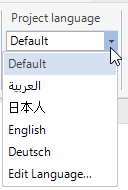
The five languages German, English, French, Spanish and Italian are already predefined. Others can be created via the context menu. Important is, that country number and language code have to be unique. The languages for the runtime are defined and selected via this dialog.
For a new project, “German” is activated by default and marked as the default language.
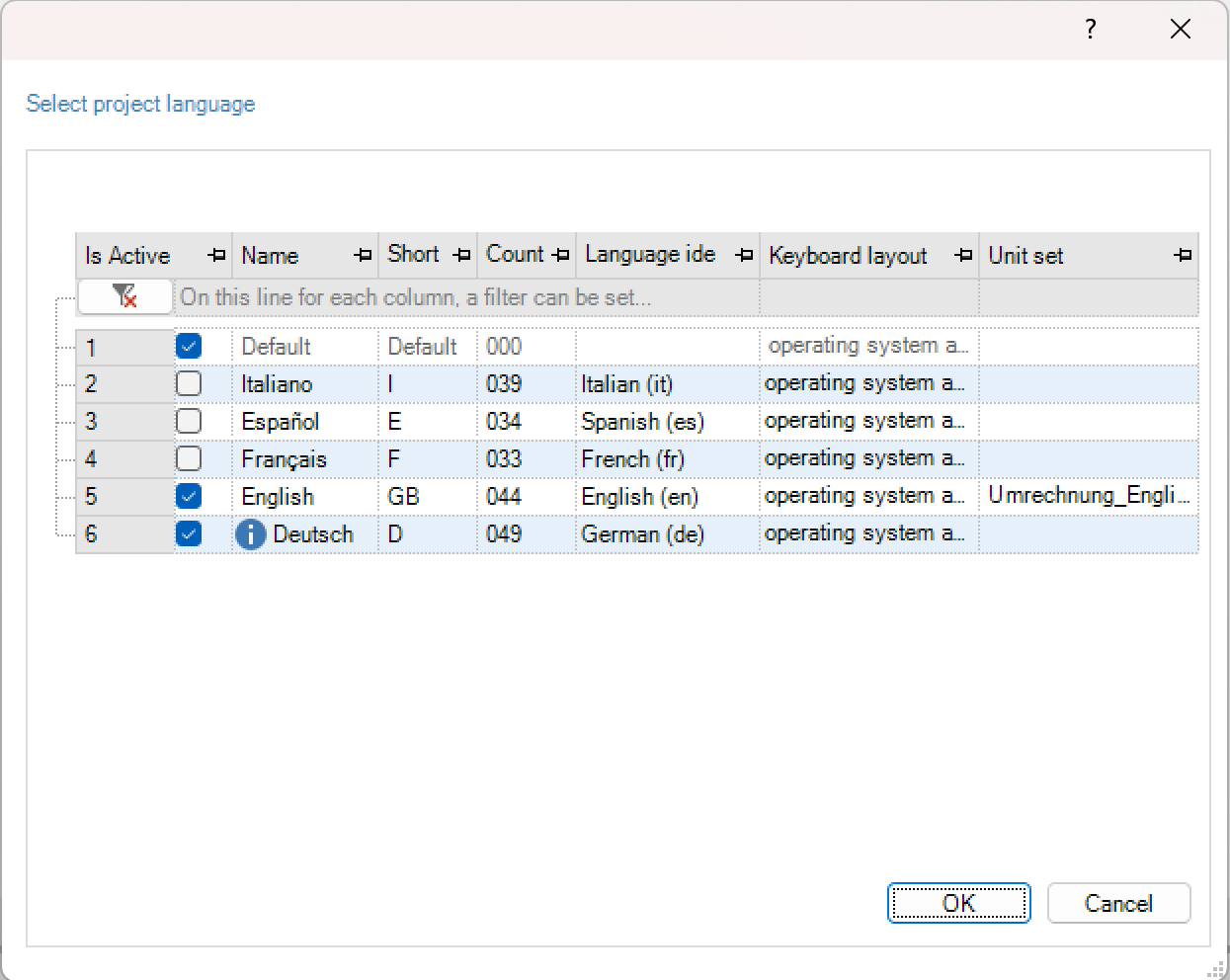
Meaning of the columns¶
Column |
Meaning |
|---|---|
Is active |
Activates / deactivates the language in the runtime |
Name |
Specifies the name of the language |
Short name |
Specifies the abbreviation for the language |
Country number |
Country code for the language (e.g., 049 for German) |
Culture code |
Specifies the language identifier (e.g., en-GB for Great Britain) |
Keyboard layout |
Change the layout of the keyboard that is shown in the Runtime e.g., QWERTZ/QWERTY or use the one of the OS |
Unit set |
Select a Unit set that is administrated in the Designer e.g. conversion cm to inch |
Set the default language¶
To mark a language as the default language, the selected language must be active. Otherwise, this is not possible. The standard language is set via the context menu (Mark as standard language). Only one language can be selected at a time.
Important
The default language cannot be deleted!
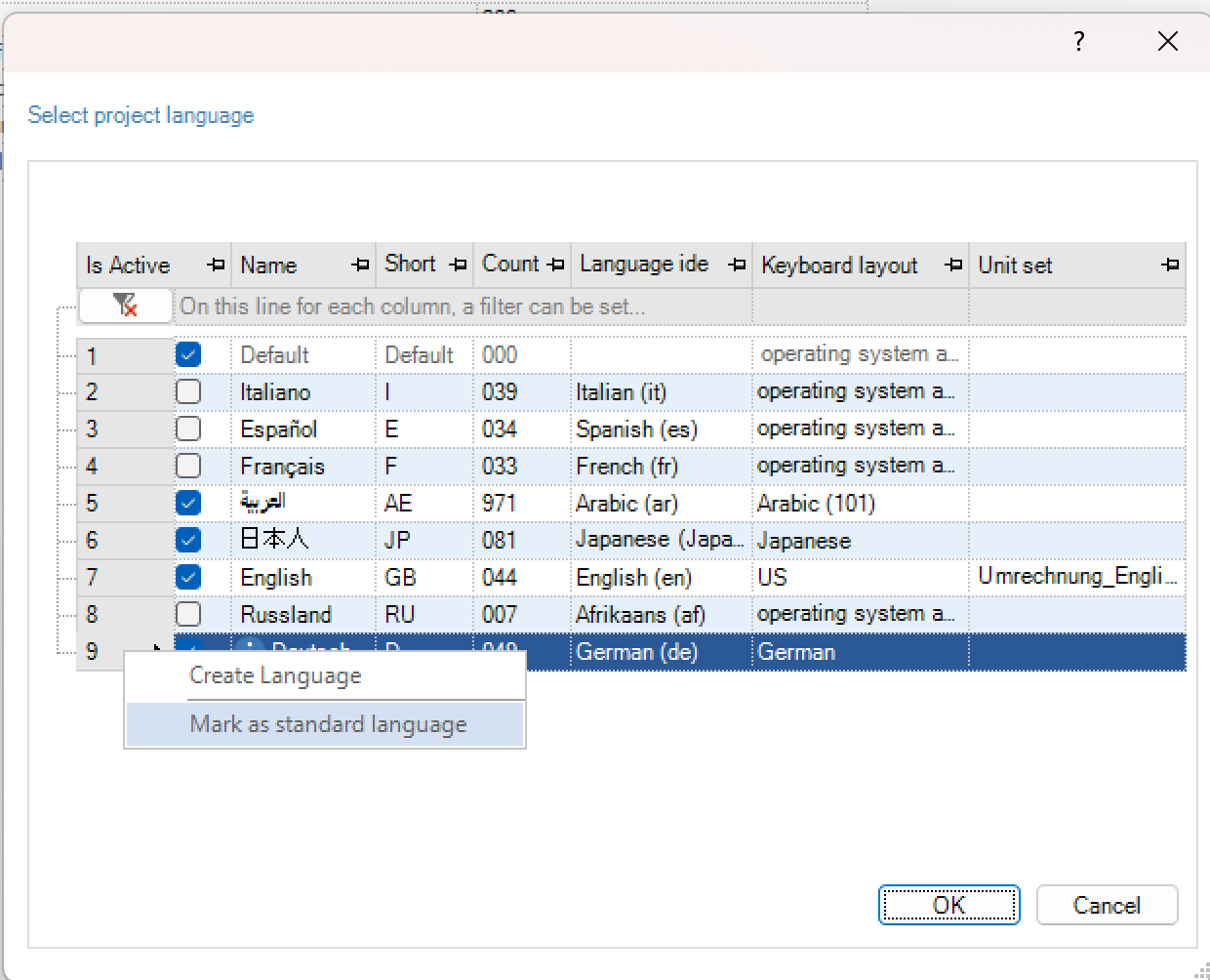
The language that is marked as the standard language is visually highlighted by an info icon in the name cell.
Project conversion from old projects¶
There are three cases that can occur when converting old projects:
No language is active (only default) -> “German” is activated and marked as the default language.
“German” is active -> “German” is marked as the standard language.
Other languages are active, but “German” is not -> One of the active languages is marked as the standard language.
Multilingual project planning¶
Pictures¶
In the picture editor, objects such as static text symbols, text constants, text variables, picture names, but also function key and diagram labels can be implemented in multiple languages. For this purpose, the project should first be configured with the language setting “Default” in a language selected by the user, since the “Default” language is displayed in the runtime if there is no translation.
Important
If the project is not configured with “Default”, no text is displayed if the translation is missing.
The language to be configured is selected in the language selection box and the corresponding text is entered in the image editor instead of the “default” language. This must be done for each language.
Note
Default texts of text tags can be configured in several languages. In the runtime, the standard values of the text variables are not switched via the language switch.
Note
Image names are displayed in the project tree in the “default” language
Alarms and system alarms¶
The alarm texts of the user-defined alarms can also be configured in the respective languages. Only the text of the set language is visible in the alarm editor.
The system alarms are already available for the standard languages. If other languages are required, the system alarms can also be translated.
Text import and export¶
With the text import and export, PROCON-WEB provides a powerful tool for efficient and fast text processing outside the designer. Any selection of the texts created in the Designer is combined into one file and can be edited and translated as a block.
The exported texts are available in XML format for further processing, for example in MS Excel.
Textexport¶
Via the “Project Environment” tab -> “Import / Export Text” -> “Text Export” opens the configuration dialog for the text export.
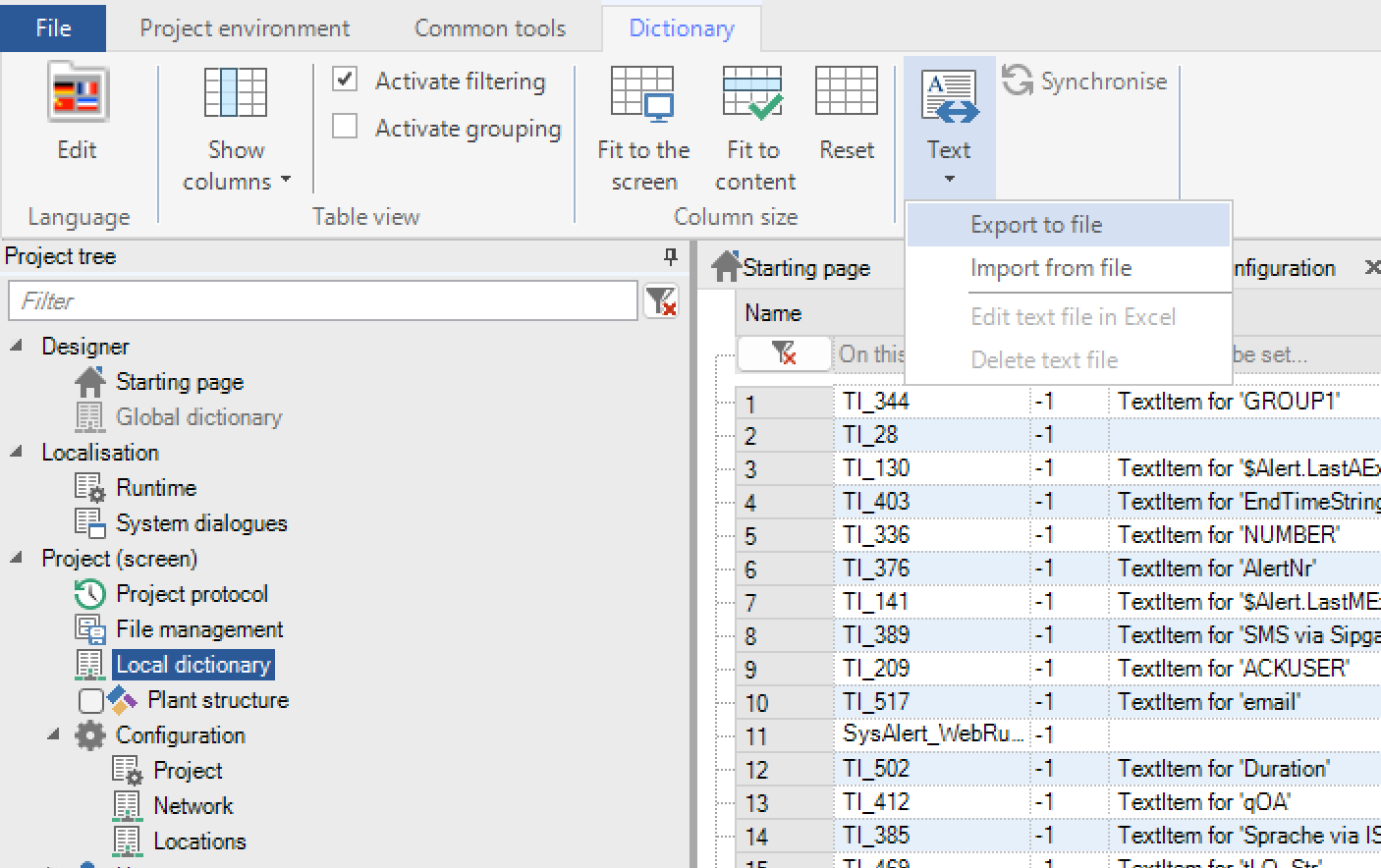
The language selection supports the export of individual or all languages known in PROCON-WEB. The following options are available in the configuration dialog
General¶
Option |
Meaning |
|---|---|
Language selection |
Selection of the languages to be exported |
Fill format |
Selection of the export path |
Important
The “default” language is always exported.

Choose text¶
Option |
Meaning |
|---|---|
All texts |
All texts used in the project are exported| |
Symbols |
Text elements in symbols |
Text-Controls |
Texts of text constants |
Simple controls |
Exports the texts of buttons, slide switches, ComboBox and CheckBox |
Complex controls |
Text elements of the data grid |
Bilder-Namen |
Picture names |
Wizard |
Text elements in the wizard and the wizard configuration |
Tooltips (picture elements) |
Text from tooltips in images |
System dialogs |
This exports the system dialogs and system texts of the runtime that are managed in the Designer |
Process variables |
Exports display name and display comment of process variables |
Alarms |
Alarm texts. Attention: Do not translate special characters and variable components (% …%)! |
System alarms |
System alarm texts Attention: Do not change special characters for system alarms with% signs!| |
Message views |
Message view texts |
Tooltips (message processing) |
Text of tooltips in alarm |
Views |
Texts of views |
XY curves |
Texts of XY curves |
PlantStruct |
Texts of plant structures |
Assigned only |
This only exports the ToolTips of selected elements that contain texts |
The text selection allows the deselection of individual texts that are not to be edited or to be edited at a later point in time. In the case of very large projects, for reasons of time and clarity, it makes more sense not to export all texts at the same time.
During the text export, the selected texts are exported to an XML file. The standard name of the export file is “TextImportExport.xml”
The exported file can be displayed and modified with MS Excel.
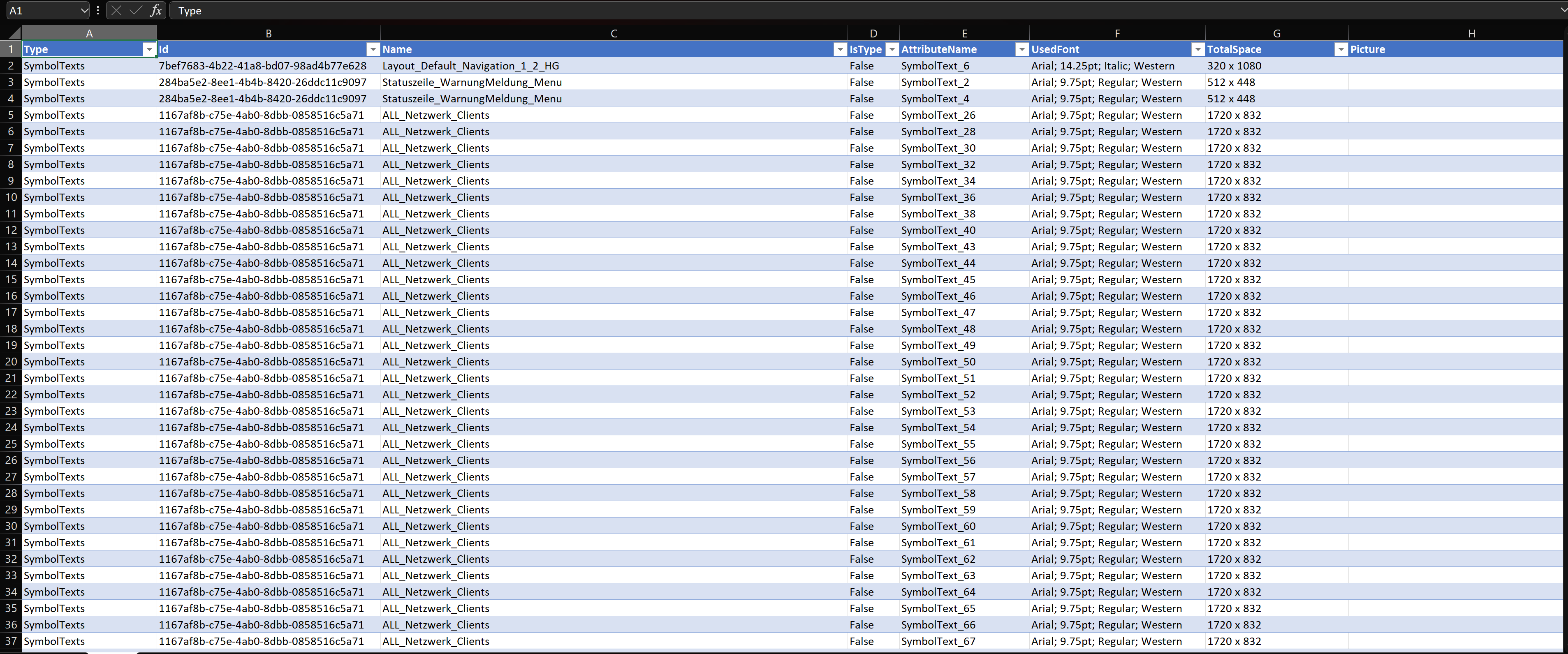
Column meaning of the export file “TextImportExport.xml¶
Language |
Text file |
|---|---|
Type |
Type of text (e.g., function keys) |
ID |
Internal ID for assigning the text |
Name |
Name of the object in the project |
IsType |
Indicates whether the exported values come from a class |
AttributeName |
Specifies the attribute name of the object (e.g., instance name of a symbol in the picture) |
UsedFont |
Specifies the font used and its size |
TotalSpace |
Indicates the size of the available space |
Picture |
Indicates the image in which the element is used |
[LANGUAGE] _Used |
Indicates the width already used for the text in the respective language. (For symbols) |
[LANGUAGE] |
Specifies the text of the respective language |
Default_Used |
Specifies the width already used for the text in the default language. (For symbols) |
Default |
Specifies the text for the default language. |
Text-Import¶
The dialog for the text import is structured similarly to the text export. If, for example, only English texts have been changed externally, you can deactivate the switch for the original German texts during import to speed up the text import process.
Edit and delete text file¶
Various menu items are available to edit the text file.
Language |
Text file |
|---|---|
Edit text file |
The export file is called up with the Windows Notepad |
Edit text file in Excel |
The export file is called up MS-EXCEL |
Delete text file |
With this menu item the export file is deleted |
Im-/Export further language files¶
In addition to exporting and importing texts, messages and tags can also be exported, edited, and then imported again as XML files. A dialog opens in which the language(s) to be exported can be selected. For the messages, as well as the tags, the texts to be displayed can be translated into the respective languages and then displayed in the runtime when selecting the respective language.

Available languages¶
The system texts of the runtime system are already available in French, Spanish, Italian, English and German. The system texts must be created and translated for each additional language. Since system texts and the corresponding application are independent of one another, it may be sufficient to deliver the project in the national language and the system texts in English. There is no need to translate the texts.